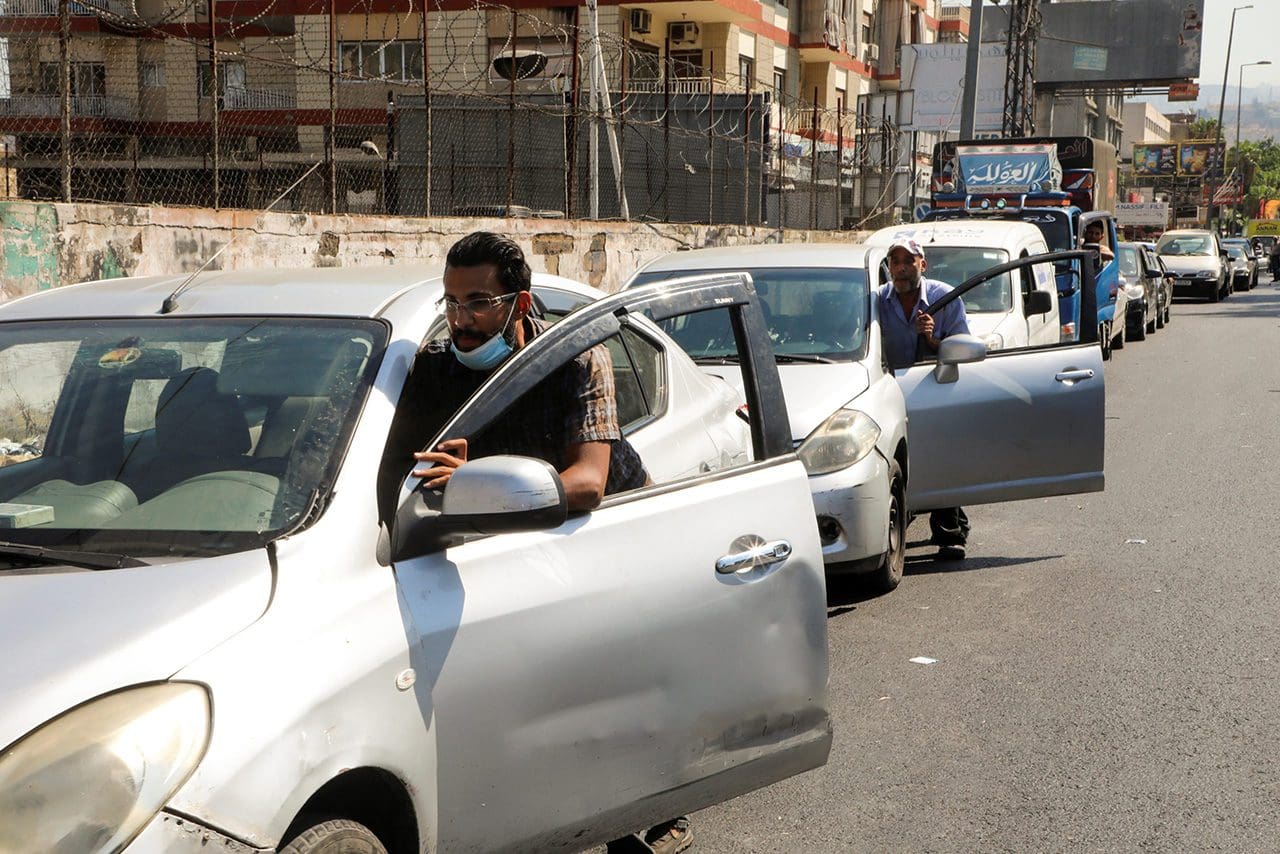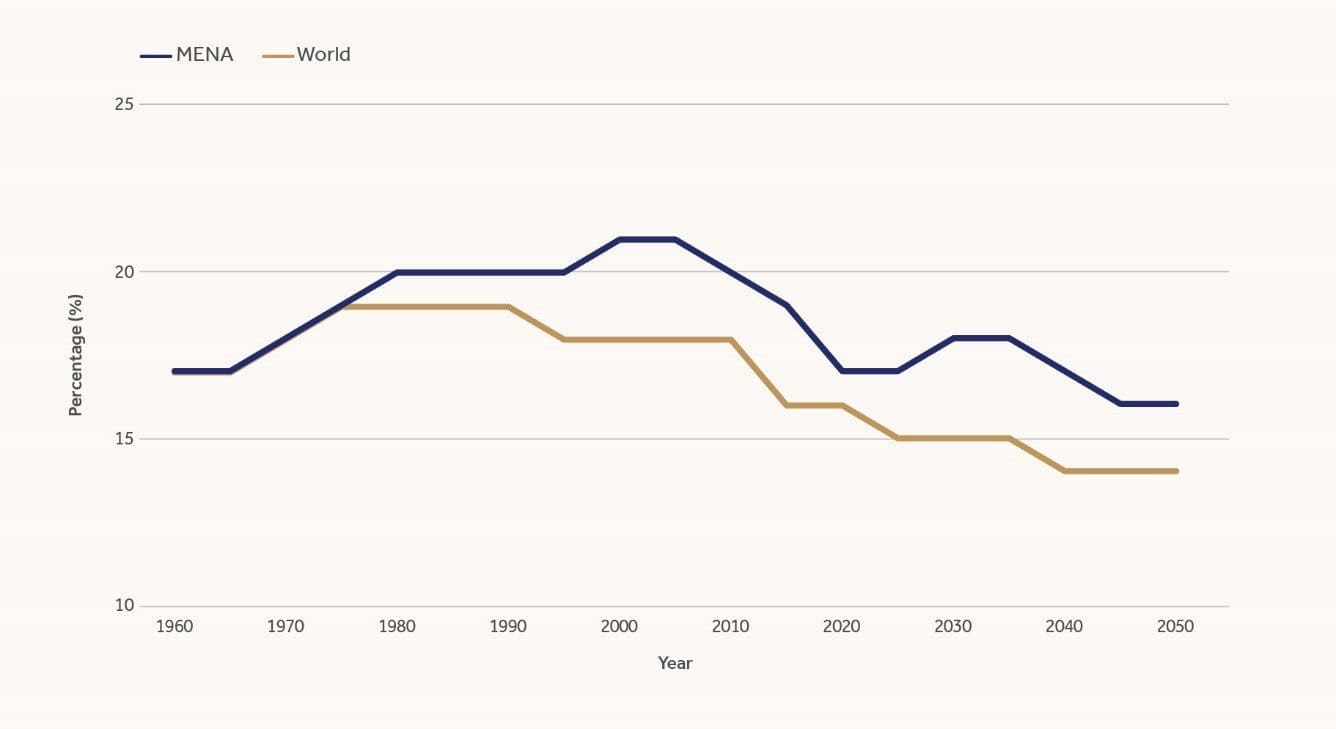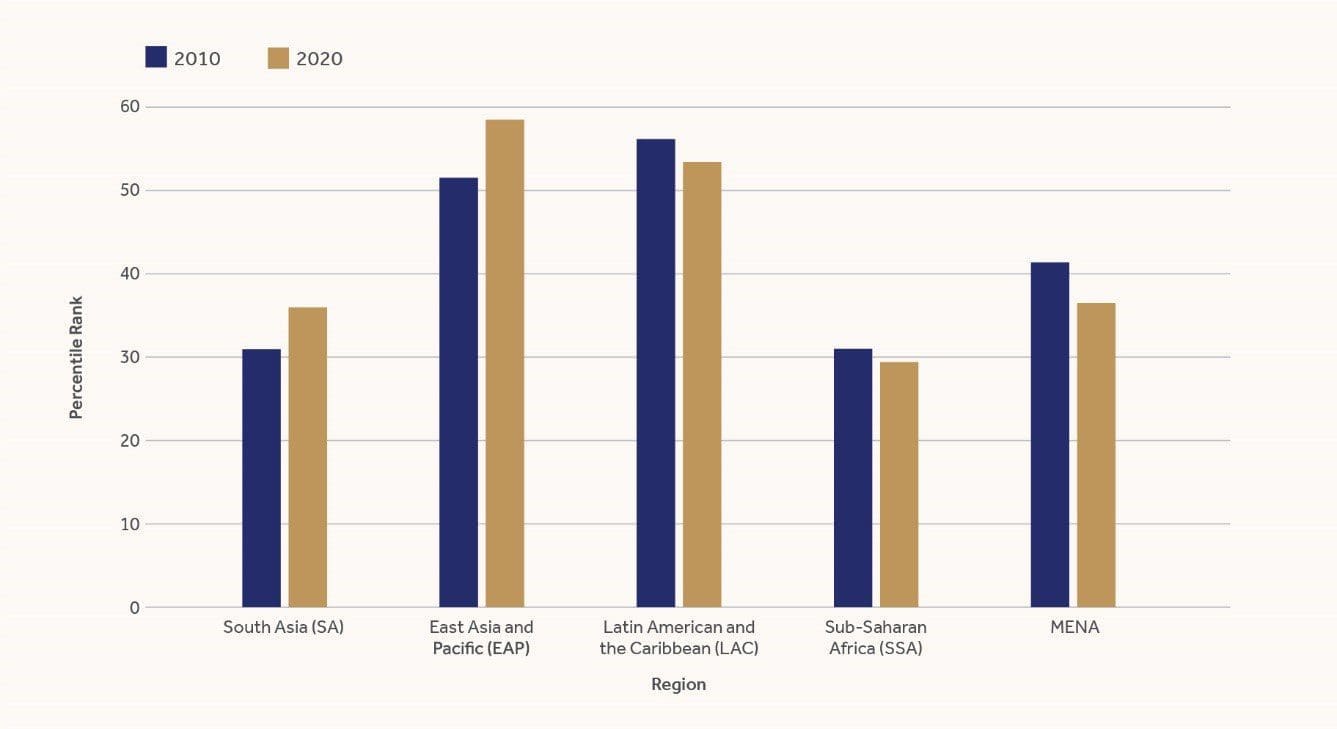
The Middle East Faces
Major Development Challenges:
Most Countries Are Not Prepared to Meet Them
Issue Brief, July 2022
Key Takeaways
Challenges Ahead
Countries of the Middle East and North Africa (MENA) region will face major economic, social, and environmental challenges over the coming decade. These challenges represent long-term trends that can be anticipated but cannot easily be avoided. Countries can only prepare for them.
Across Multiple Dimensions
These challenges include financial pressures from long-term downward trends in global energy prices; competitive pressures from advances in digitalization; increased water scarcity and rural-urban migration resulting from climate change; and greater labor supply pressures due to demographic trends.
Governance Deficits Persist
At the same time, MENA countries suffer from governance deficits that will prevent them from dealing with these challenges effectively. These governance deficits include weak public institutions, frayed state-citizen relations, exclusionary economic systems, and fragile interstate relations.
Needed: A New Development Paradigm
Overcoming these governance deficits requires a paradigm shift in MENA states’ approach to governance and development, including emphasizing incremental improvements over major reforms, enhancing transparency and accountability, and creating space for meaningful citizen participation.
Introduction
The Middle East and North Africa (MENA) region faces major challenges over the coming decade that will test its institutions and require its governments to design more effective policy solutions. On the economic front, the long-term downward trajectory in regional oil reserves and global energy prices will increase financial pressures across the region. On the technological front, advances in digitalization, artificial intelligence, and automation will create competitive pressures for both businesses and workers. On the environmental front, climate change will have a profound impact, especially as it relates to regional water scarcity. Finally, on the social front, a demographic wave will increase population and labor supply pressures, replicating conditions that foreshadowed the unrest of 2011.
These challenges represent long-term trends that can be anticipated but cannot easily be avoided. Countries must simply prepare for them. For countries that prepare and respond successfully, these challenges represent opportunities for economic development and institutional growth. Countries that fail to deal with them effectively face the prospect of economic hardship, political instability, and social unrest. Unfortunately, most MENA countries suffer from internal governance deficits that will prevent them from successfully addressing these external challenges and converting them into opportunities. These deficits include weak institutions; frayed state-citizen relations; exclusionary systems that limit the participation of key segments of society; and, at the regional level, fragile interstate relations.
MENA’s track record in addressing external challenges is not reassuring. The late 1980s and 1990s were a period of low oil prices and economic stagnation for oil producing and non-oil producing countries alike. Responding to fiscal pressures, governments reduced access to public sector jobs1 and the quality of public services declined.2 However, cronyism and corruption stunted the growth of a competitive private sector that could create new sources of employment3. MENA states also tightly regulated civil society, preventing it from covering emerging gaps in public service delivery.4 Within this context, a youth bulge resulting from a demographic transition hit the region, placing further pressure on the region’s education systems and labor markets5. As a result, youth unemployment increased6 and the informal sector grew.7 Public frustration swelled across the region, erupting in 2011 into civil unrest.
MENA states knew that economic and demographic pressures were building up. They also knew what needed to be done. But they failed to overcome internal institutional weaknesses and initiate the types of economic reforms that would have allowed their private sectors to grow, creating needed jobs. On the contrary, the reforms they introduced benefited insiders and limited competition and growth. Today, there is a tight window of opportunity for MENA countries to initiate necessary reforms and prepare for the coming trials. Time is of the essence; the global COVID-19 pandemic has exacerbated the situation and reduced the fiscal space for states to act. This issue brief outlines the main challenges facing the MENA region and discusses the governance deficits that it must address to deal with them.
Major Challenges Facing the Region in the Coming Decade
The external challenges that will hit the MENA region in the coming decade are similar to those of the past, but they will be more numerous and self-reinforcing. The region faces a perfect storm of concurrent economic, social, and environmental threats. At the same time, the internal institutional capacity of MENA countries to deal with them has fallen. Avoiding hypothetical scenarios, such as a new global pandemic, and focusing on issues around which there is some consensus,8 four external challenges stand out: energy transition, climate change, technological transformation, and demographic trends.
Such challenges can be positive or negative. The outcome ultimately depends on how countries respond to them. For example, countries experiencing youth bulges can reap a demographic dividend if they create enough jobs for them. In this scenario, a relatively large workforce supports fewer dependents, allowing countries to realize greater savings, investment, and economic growth. Similarly, countries that face declining natural resources can divert revenues from the remaining resources to diversify their economies. It is only when countries fail to deal with external challenges that they become overwhelmed by them.
Energy Transition
The MENA region has been blessed with an abundance of natural energy resources. These have allowed resource-rich economies to accelerate their economic and human development. MENA countries with few energy resources have also benefited from this windfall through remittances, investments, and development assistance. Of the three, remittances have been the most important, reaching USD 25 billion in transfers from the Gulf countries to the rest of MENA in 2017.9 Over the past half century, people from across the region have escaped the dearth of employment opportunities in their home countries by finding work in energy-rich economies, reducing labor market pressures back home.
Revenues from oil and natural gas11 will not flow forever. Despite recent increases in global energy prices, triggered by the Russia-Ukraine conflict, the coming decade will witness a steady decline in oil reserves, beginning with Bahrain and Oman.10 Furthermore, long-term trends will exert downward pressures on both global energy prices and demand as the world transitions to a post-carbon future. The timing of this transition is hotly debated. However, it is likely to accelerate in the coming decade as global commitments to a net-zero carbon future advance, renewable sources become cheaper, and energy storage and transportation become easier and more affordable. The MENA region is not yet prepared for this change. Countries continue to rely, directly or indirectly, on revenues from natural resources to support large public bureaucracies and rent-seeking private businesses.
Energy transition presents both a challenge and an opportunity. Despite decades of good intentions and policy initiatives, resource-rich countries have failed to diversify their economies and remain dependent on revenues from oil and natural gas. While they currently have enough time and wealth to initiate a smooth transition to a post-oil economy, too often this wealth is being squandered on expensive national projects rather than being used to support changes to the entire business ecosystem that would allow the development and growth of globally competitive industries. In the end, resource-rich economies must replace oil and gas with other goods and services that can be traded with the rest of the world. In addition, non-oil producing countries must accelerate their own economic reforms in anticipation of declining migration opportunities and remittances.
Climate Change
The flipside of energy transition is climate change; the economic, social, and environmental fallout from which MENA must manage like all other regions. While the other challenges discussed in this brief can be a blessing or a curse, climate change mainly involves managing downside risks. These risks include rising temperatures, extended episodes of drought, volatile weather patterns, greater food insecurity, increased rural-urban migration, and rising sea levels that threaten coastal communities. Climate change will exacerbate the impact of population growth, slow the pace of economic development, threaten the lives and livelihoods of vulnerable populations, and create fodder for social unrest.
Dealing with climate change will require pre-emptive planning and the allocation of resources to manage these downside risks. What sets MENA apart, and provides an added sense of urgency, is that the region is by far the most water-stressed in the world. It has renewable internal water resources of only 520 cubic meters per person – less than one seventh that of the next closest region, Sub-Saharan Africa.12 Furthermore, most MENA countries are overusing their groundwater reserves rather than conserving them, exhausting a buffer that should be drawn on only in times of drought.13 Also, in many cases, the region has succumbed to the notion that environmental efforts must be green, and MENA governments have taken to planting trees in arid areas that cannot naturally sustain them.
Competition over scarce water resources may increase internal and regional conflict. The Syrian conflict was proceeded by a three-year drought that led to the internal displacement of 300,000 people. While not a direct cause of the unrest that followed, it may have contributed to underlying social fractures that allowed the conflict to spread.14 Moreover, much of the region’s fresh water originates in other countries, creating the potential for regional conflict. For example, the Nile River, Egypt’s life source, originates in Ethiopia and passes through Sudan; the Grand Ethiopian Renaissance Dam has become a hotspot for conflict between the three states.15 Mitigating water stress will require improved conservation efforts, better water reclamation and reuse projects, reorienting agricultural and environmental initiatives to better account for the arid nature of the region, and improving regional cooperation.
Technological Innovation
A third global trend that has yet to fully impact the region is technological innovation. Digitalization, artificial intelligence, and automation are changing the way consumers, producers, and workers interact with the world. The next round of technological innovation will revolutionize not only manufacturing, but services and agriculture as well. An estimated 45 percent of work activities in MENA could potentially be automated in sectors as diverse as manufacturing, transportation, construction, hospitality, and retail.16 At the same time, new technologies will make it easier to produce, consume, and work locally while being connected to global supply chains and labor markets. They could also potentially increase the ability of marginalized communities to participate economically and even to compete globally.
MENA lags other developing regions in many aspects of technology adoption. In terms of access, mobile-cellular subscriptions are on a downward trajectory, and active mobile-broadband subscriptions are far behind the rest of the world, except for Africa.17 Indeed, MENA is the only developing region whose ranking of telecommunications technology adoption has fallen since 2008.18 This is surprising, since the region is less digitally isolated than other developing regions. Firms in MENA are, on average, located closer to telecommunication cable landing stations than firms in other developing regions.19 However, MENA countries have not been able to take advantage of their proximity to landing stations or global trade routes to enhance the connectivity of their citizens or the competitiveness of their firms. Key reasons include the lack of market liberalization and regulatory independence.20
Demographic Transition
On the social front, a second demographic wave is about the hit the MENA region (figure 1). This wave is composed of children of the first wave that were young in the 2000s. The second wave has already begun to exert pressure on the region’s education systems and labor markets. Its peak will hit around 2035 with youth population shares of 18.3 percent, as compared to a global average of 14.9 percent.21 The timing will differ across countries and not all MENA countries will be affected to the same extent. Countries that will be most affected include Egypt, Sudan, Iraq, Jordan, Palestine, and Yemen.22
Figure 1: Share of Youth (15-24) in the Population

This second demographic wave is smaller than the first, but still significant. Fertility rates across the region have not declined as fast as was expected, partly because women remain outside the labor force, despite substantial gains in educational attainment. Yet, even though the region will not experience the same labor force pressures as the first wave, the second wave’s impact is likely to be compounded by the impact of the other external challenges. If the Gulf states’ plans for economic diversification stall, the region will lose an important resource for absorbing labor supply pressures. Furthermore, competitive pressures resulting from technological innovation and increased rural-urban migration due to climate change might reduce the availability of good jobs, further exacerbating labor supply pressures caused by the demographic transition.
Governance Deficits Are Preventing MENA from Capitalizing on the Challenges
Each of these external challenges, on its own, seems manageable. Combined, however, they represent a formidable storm on the horizon. If MENA countries can orient their economies and institutions to take advantage of these opportunities, they can spur development and growth. Unfortunately, MENA countries lack the institutional capacity to successfully address many of these challenges. While there is still enough time to prepare, states must first overcome key governance deficits that have held them back: frayed state-citizen relations, weak institutions, exclusionary systems, and fragile Interstate relations.
Frayed State-Citizen Relations
MENA is the least democratic region in the world. No MENA country is truly free and only a handful have some, albeit constrained, democratic institutions. Tunisia, the only MENA country to be classified “free” by Freedom House,23 will surely lose this designation following President Kais Saied’s seizure of executive power in July 2021. In the past, most citizens appeared to accept this lack of democracy and participation as part of an authoritarian bargain, in which people give up some political rights in exchange for public benefits, services, and jobs.24 However, beginning in the mid-1980s, in the face of growing fiscal constraints, MENA states began to renege on their end of the bargain, reducing public services and public sector employment. The Arab Spring was the inevitable outcome of this broken social contract.
In principle, the old social contract can be fixed by removing expensive energy price subsidies, closing unprofitable state enterprises, and allowing the private sector to grow and create jobs.25 However, insiders who benefit from arbitrage opportunities and exclusive contracts have prevented meaningful reform. Rather than instigate reforms or negotiate more inclusive social contracts, MENA states have instead opted to increase repression and use public benefits to reward regime loyalists.26 The issue goes deeper still, MENA societies have deep tribal and confessional connections that are often stronger than their allegiance to the state. This makes it difficult for individuals to resist family and tribal pressures in the service of bureaucratic norms such as merit-based employment and conflicts of interest. Institutional reforms must take these social norms, incentives, and constraints into account.
Navigating the coming challenges requires citizens and states to work together to create new economic opportunities. For this to happen, MENA leaders must establish clearer rules of the game that define the lines between spheres where social connections will be tolerated and spheres where they will not. MENA states should then allow their citizens to operate freely within these rules. For example, under present circumstances, it is unrealistic to expect leaders to prevent insiders and loyalists from benefiting from economic rents. However, the latter’s reach should be limited to sectors with natural economic rents. States should prevent insiders from erecting barriers to competition and create artificial economic rents, especially in sectors that form the foundation of economic competitiveness and growth. Sectors such as technology, manufacturing, and business services should be allowed to function freely.
Weak Institutions
The MENA region needs effective, flexible, adaptive institutions to tackle the coming challenges. Public institutions must be able to adapt to changing circumstances and coordinate complex policies.27 Unfortunately, the past decade has witnessed a steep erosion in the quality of public institutions and governance across the region. The region’s average aggregate ranking on the World Bank’s governance indicators has fallen by 12 percent since 2010 (figure 2).28 The steepest declines were in the areas of political stability, control of corruption, and government effectiveness. These declines have proceeded unfettered because of deep gaps in voice and accountability,29 in which MENA lags far behind the rest of the world. Even mild criticism of the state can incur strong retribution.
Figure 2: Average Percentile Rank, World Bank Governance Indicators (2010-2020)

These governance issues are partly due to the region’s autocratic tendencies at all levels of society, from the state to the private sector, down to the level of the family and the clan. The region must find a way to moderate these tendencies in a world that increasingly requires innovative, bottom-up solutions. One place to start is allowing more space for voice, accountability, and transparency. If public agencies can insulate themselves from criticism, they face little incentive to identify internal weaknesses and work to improve them. Some MENA governments have achieved improvements in governance, by turning to e-government solutions which limit the space for corruption and arbitrary bureaucratic decisions. Governments should also improve public sector monitoring and evaluation, vesting this key function within an agency reporting to the highest authority. Finally, MENA governments should create an ombudsman function, where citizens can take concerns and complaints without risk of retribution.
Limited Inclusion
Another area where the MENA region is especially weak is the issue of inclusion. Key segments of society, including women, young people, rural communities, refugees, and other marginalized groups, do not have adequate access to economic opportunities. As a result, large segments of the population are not productive and do not contribute to economic development. This wasted potential comes at a cost, including forgone income, weaker economic growth, and more limited innovation.
To illustrate this loss of potential, consider women. Female labor force participation in MENA is the lowest in the world at 19.8 percent in 2019, less than half the global average of 47.3 percent, while female unemployment rates are the highest in the world at 17.7 percent, three times the global average of 5.52 percent.30 This means that even women who want to work are not able to find acceptable jobs. This is a massive waste of human potential. Another case of wasted potential is refugees. The MENA region was home to over 9 million refugees in 2019, the largest refugee population in the world in both absolute and relative terms.31 Most refugees are not able to access formal work and are forced to rely on humanitarian assistance or to work illegally. While governments frame this lack of access in economic terms, the reality is often political. Most refugees take menial jobs that citizens do not want. For example, while Jordan hosts over a million Syrian refugees, Syrian workers represent only 20 percent of the migrant workforce, with larger numbers of Egyptian workers than Syrians.32
Fragile Interstate Relations
A final institutional weakness is deteriorating inter-state relations across the region. Most of the challenges facing the MENA region are regional in nature and require regional collaboration, or at least cooperation. Instead, regional rivalries have set the region back. Internal conflicts in Yemen, Syria, and Libya have drained resources and reversed hard-won gains in human development outcomes.33 Rather than working to resolve these conflicts, regional involvement has exacerbated and prolonged the crises. Furthermore, regional rivalries have served as a financial drain, diverting scarce financial resources away from development priorities, with few clear benefits. In 2020, Gulf countries collectively spent USD 100 billion on their defense budgets.34 Yet, military interventions in Yemen and Libya have backfired, as have regional powerplays against neighbors, such as the 2017 blockade against Qatar.
The region’s record in resolving internal conflicts and regional disputes has been dismal. Regional institutions such as the Arab League and the Gulf Cooperation Council have had virtually no influence in moderating or resolving disputes. Flashpoints are increasing as proxy conflicts have extended into Lebanon, Sudan, Somalia, and the Sahel. At a time when serious global challenges are confronting the entire region, MENA countries need to find ways of resolving disputes and working together more effectively. There is an added layer of urgency. Competition among global and regional powers is increasing. The United States and China are at odds. Russia has been reasserting its role as a global power. Divided MENA countries might easily become pawns or collateral damage in the global struggle for power.
Towards a New Development Paradigm for the Region
MENA countries face a host of interconnected economic, social, and environmental challenges. Yet, most countries lack the institutional capacity to deal with them due to internal governance deficits. While the external challenges outlined in this brief are the culmination of long-term trends that are difficult to avoid, the governance deficits are internal and, thus, in principle, are within the region’s ability to address and overcome. In reality, however, MENA states have struggled to improve their institutional capacities. MENA is the only region in the world that has witnessed a decline in governance outcomes.
This issue brief outlined key governance deficits that the region must strive to overcome. However, to succeed, the region needs to develop a new, more systematic approach to dealing with them. First, rather than try to institute major top-down economic or political reforms, MENA countries should aim for incremental improvements. The aim is to stop the downward spiral and begin heading in the right direction. Second, MENA countries must build their institutional capacity by increasing merit-based systems, transparency, and accountability. This will require a major shift in thinking and acting. Third, states need to create space for citizens to meaningfully contribute to the development of their countries. This will require leaders to moderate the authoritarian tendencies of both citizens and the state.
In short, overcoming the plethora of governance deficits requires a paradigm shift in the region’s approach to governance and development. Reversing governance deficits and building institutional capacities require time and effort. While the region currently has the resources to manage the required changes, these resources are declining and it will soon begin to feel the pinch of the looming external challenges. Forging ahead requires strong leadership with a clear vision of a more inclusive and liberal development paradigm and a willingness to clearly articulate and enforce the new rules of the game.

